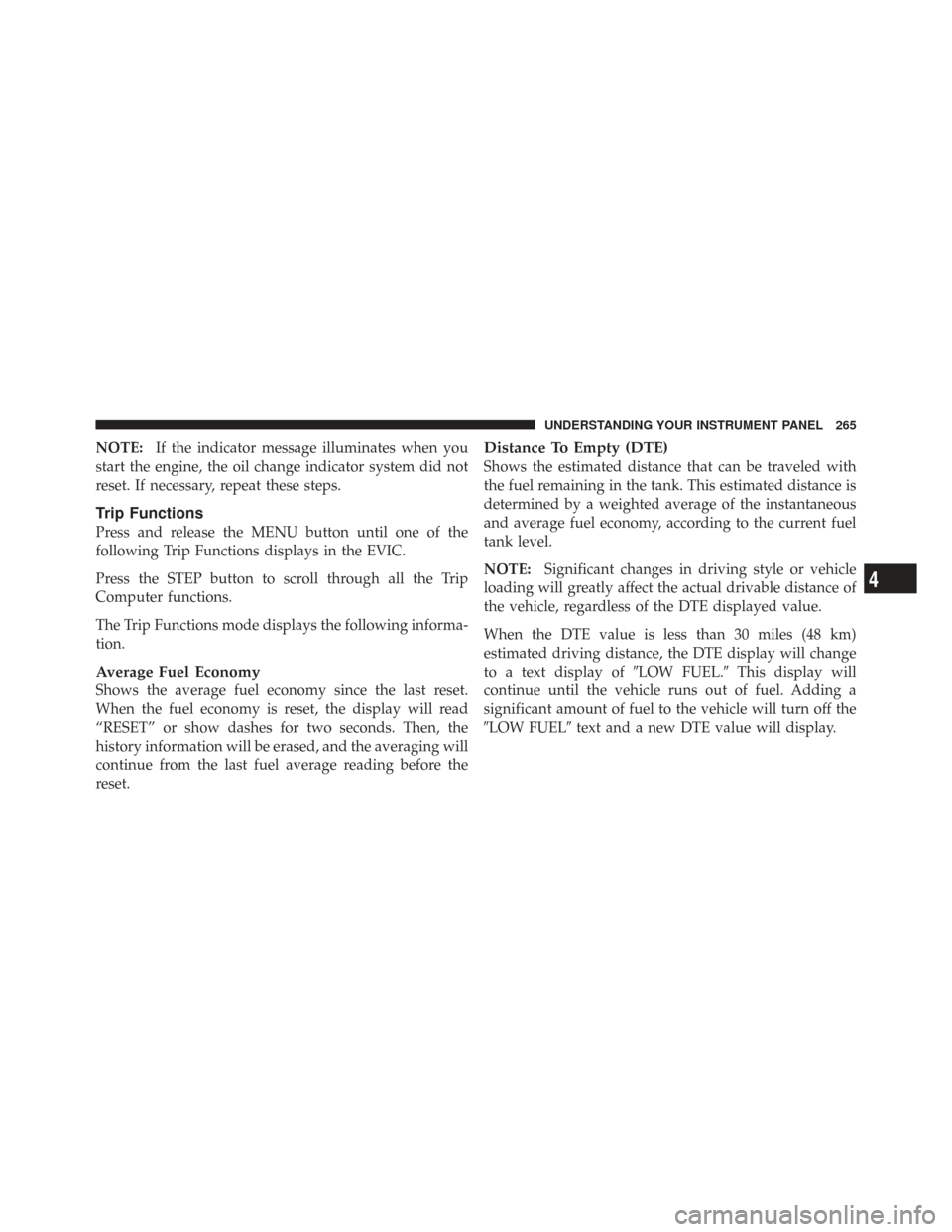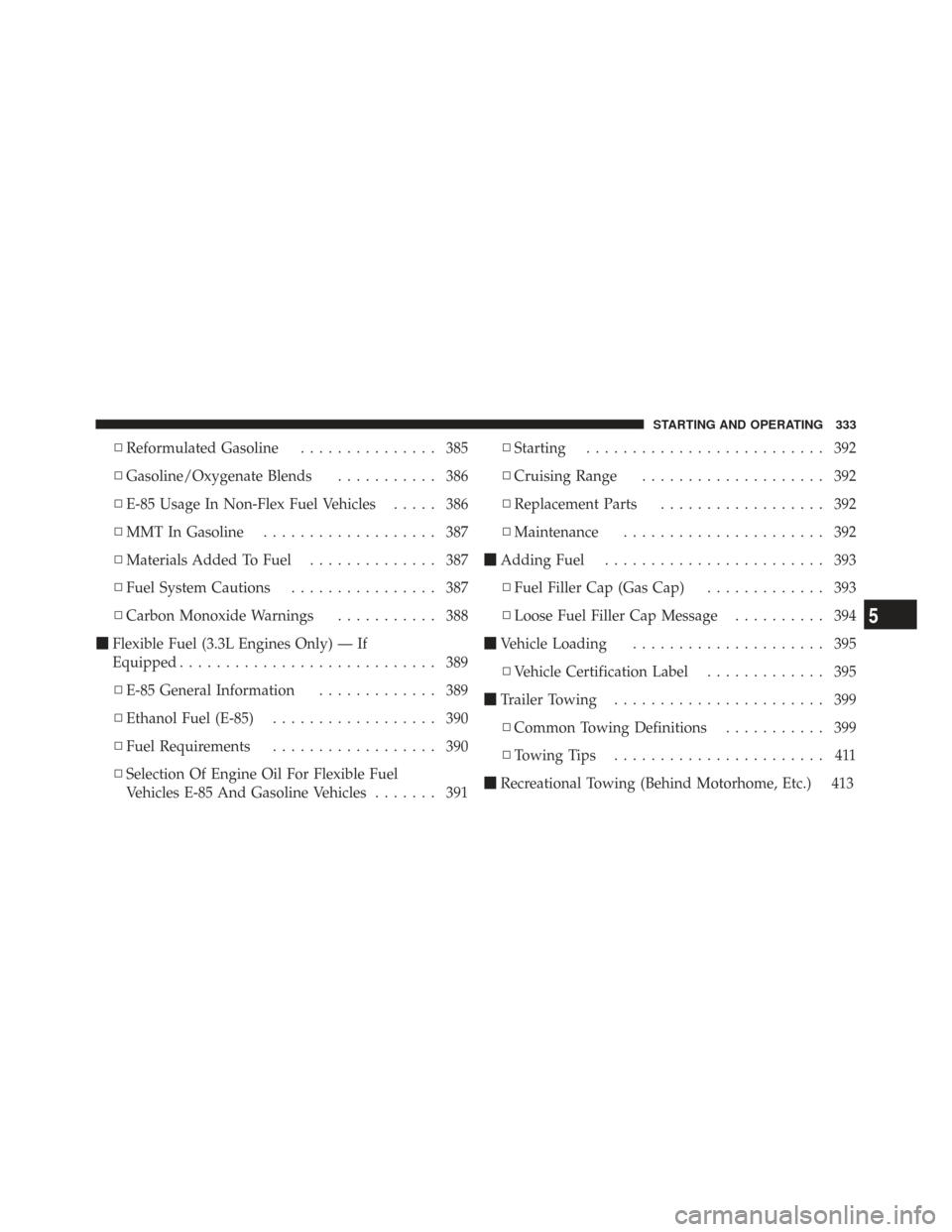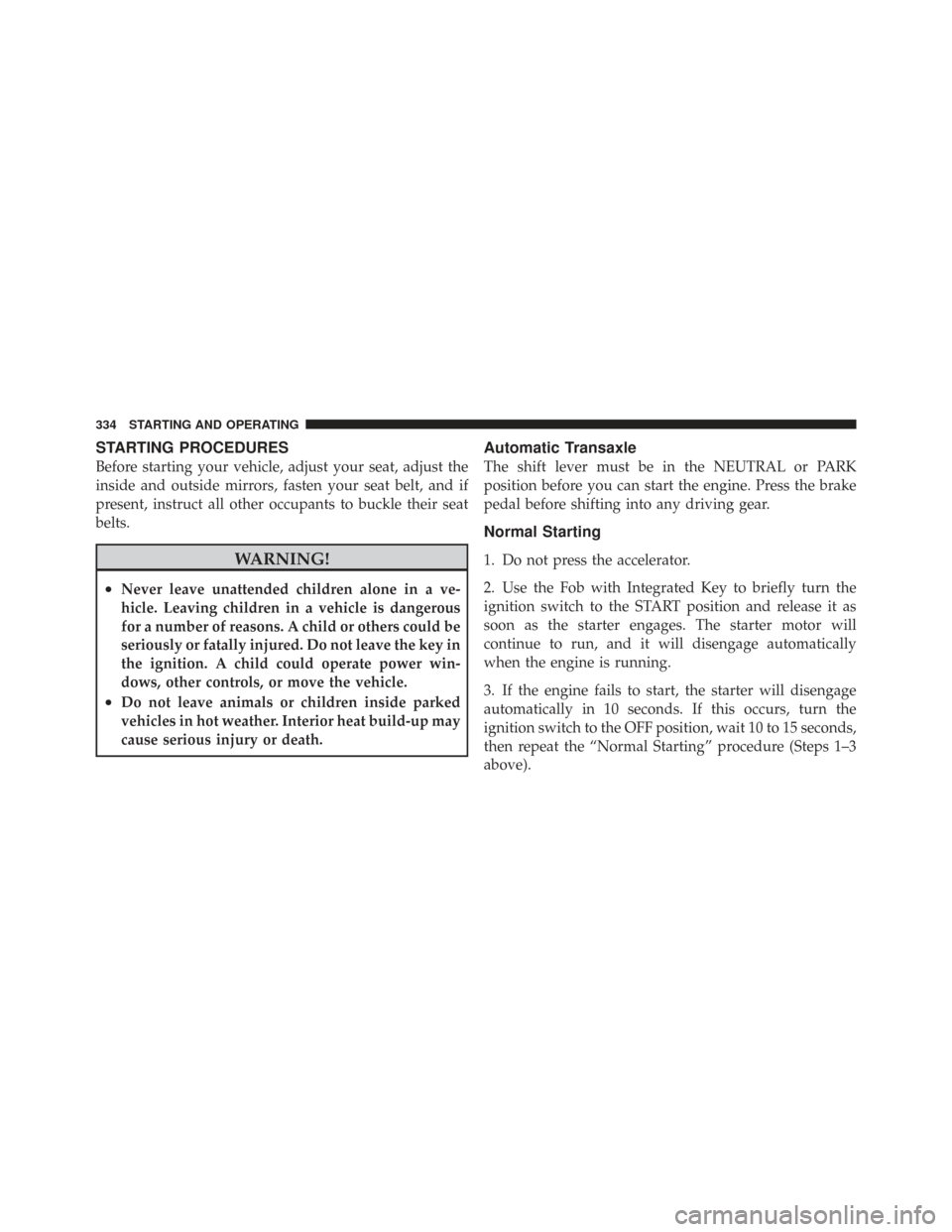Page 267 of 543

NOTE:If the indicator message illuminates when you
start the engine, the oil change indicator system did not
reset. If necessary, repeat these steps.
Trip Functions
Press and release the MENU button until one of the
following Trip Functions displays in the EVIC.
Press the STEP button to scroll through all the Trip
Computer functions.
The Trip Functions mode displays the following informa-
tion.
Average Fuel Economy
Shows the average fuel economy since the last reset.
When the fuel economy is reset, the display will read
“RESET” or show dashes for two seconds. Then, the
history information will be erased, and the averaging will
continue from the last fuel average reading before the
reset.
Distance To Empty (DTE)
Shows the estimated distance that can be traveled with
the fuel remaining in the tank. This estimated distance is
determined by a weighted average of the instantaneous
and average fuel economy, according to the current fuel
tank level.
NOTE: Significant changes in driving style or vehicle
loading will greatly affect the actual drivable distance of
the vehicle, regardless of the DTE displayed value.
When the DTE value is less than 30 miles (48 km)
estimated driving distance, the DTE display will change
to a text display of �LOW FUEL.�This display will
continue until the vehicle runs out of fuel. Adding a
significant amount of fuel to the vehicle will turn off the
�LOW FUEL� text and a new DTE value will display.
4
UNDERSTANDING YOUR INSTRUMENT PANEL 265
Page 317 of 543
•The A/C can be deselected manually without disturb-
ing the mode control selection.
Economy Mode
If ECONOMY mode is desired, press the A/C button to
turn off the indicator light and the A/C compressor.
Rotate the temperature control knob to the desired
temperature.
Air Conditioning Operation
Push on this button to engage the Air Condition-
ing (A/C). A light will illuminate when the A/C
System is engaged
NOTE: The air conditioning compressor will not engage
until the engine has been running for about 10 seconds.
Max A/C
For maximum cooling use the A/C and RECIRCULA-
TION mode buttons at the same time.
Three-Zone Temperature Control — If Equipped
With the Three-Zone Temperature Control System, each
front seat occupant can independently control the Heat-
ing, Ventilation, and Air Conditioning operations coming
from the outlets on their side of the vehicle.
4
UNDERSTANDING YOUR INSTRUMENT PANEL 315
Page 324 of 543

cold or hot vehicles. The system automatically adjusts
the temperature, mode and fan speed to provide
comfort as quickly as possible.
•The temperature can be displayed in English or Metric
units by selecting the “Display Units of Measure in”
customer-programmable feature. Refer to the “Elec-
tronic Vehicle Information Center (EVIC) — Customer-
Programmable Features” in this Section.
To provide you with maximum comfort in the automatic
mode, during cold start-ups, the blower fan will remain
on low and the DELAY symbol will appear in the front
ATC display, until the engine warms up. The fan will
engage immediately if the DEFROST mode is selected, or
by pressing the Front Upper ATC Panel blower rocker
button and setting the fan to any fixed blower speed.
Manual Operation
This system offers a full complement of manual override
features. The AUTO symbol in the front ATC display will
be turned off when the system is being used in the
manual mode.
NOTE: Each of these features operate independently
from each other. If any one feature is controlled manually,
the temperature doors will continue to operate automati-
cally.
The blower fan speed can be set to any fixed speed by
pressing the Front Upper ATC Panel blower rocker
button. The fan will now operate at a fixed speed until
additional speeds are selected. This allows the front
occupants to control the volume of air circulated in the
vehicle and cancel the AUTO mode.
The operator can also select the direction of the airflow
by selecting one of the following positions.
322 UNDERSTANDING YOUR INSTRUMENT PANEL
Page 330 of 543

NOTE:In many temperature positions, the BI-LEVEL
mode is designed to provide cooler air out of the head-
liner outlets and warmer air from the floor outlets.
Floor Mode Air comes from the floor outlets.
Summer Operation
The engine cooling system in air conditioned vehicles
must be protected with a high-quality antifreeze coolant
to provide proper corrosion protection and to protect
against engine overheating. A solution of 50% ethylene
glycol antifreeze coolant and 50% water is recommended.
Refer to “Maintenance Procedures” in Section 7 of this
manual for proper coolant selection.
Winter Operation
To ensure the best possible heater and defroster perfor-
mance, make sure the engine cooling system is function-
ing properly and the proper amount, type, and concen-
tration of coolant is used. Refer to “Maintenance
Procedures” in section 7 of this manual for proper coolant
selection. Use of the air RECIRCULATION mode during
Winter months is not recommended, because it may
cause window fogging.
Vacation/Storage
Before you store your vehicle, or keep it out of service
(i.e., vacation) for two weeks or more, run the air
conditioning system at idle for about five minutes, in
fresh air with the blower setting on high. This will ensure
adequate system lubrication to minimize the possibility
of compressor damage when the system is started again.
328 UNDERSTANDING YOUR INSTRUMENT PANEL
Page 333 of 543
STARTING AND OPERATING
CONTENTS
�Starting Procedures ................... 334
▫ Automatic Transaxle ................. 334
▫ Normal Starting .................... 334
▫ Extreme Cold Weather (Below �20°F Or
–29°C) ............................ 335
▫ If The Engine Fails To Start ............ 335
▫ After Starting ...................... 336
� Engine Block Heater — If Equipped ....... 336
� Automatic Transaxle .................. 337 ▫
Brake/Transaxle Interlock System ....... 337
▫ Four-Speed Or Six-Speed Automatic
Transaxle .......................... 338
▫ Gear Ranges ...................... 339
� Driving On Slippery Surfaces ............ 344
▫ Acceleration ....................... 344
▫ Traction .......................... 344
� Driving Through Water ................ 345
▫ Flowing/Rising Water ................ 345
5
Page 334 of 543

▫Shallow Standing Water .............. 345
� Power Steering ...................... 347
▫ Power Steering Fluid Check ........... 348
� Parking Brake ....................... 349
� Anti-Lock Brake System (ABS) ........... 350
▫ Anti-Lock Brake Warning Light ......... 352
� Electronic Brake Control System .......... 353
▫ Traction Control System (TCS) .......... 353
▫ Brake Assist System (BAS) ............. 354
▫ Electronic Stability Program (ESP) ....... 355
▫ ESP/BAS Warning Light .............. 356
� Tire Safety Information ................ 357
▫ Tire Markings ..................... 357 ▫
Tire Identification Number (TIN) ........ 361
▫ Tire Loading And Tire Pressure ......... 362
� Tires — General Information ............ 366
▫ Tire Pressure ...................... 366
� Tire Chains ......................... 373
� Snow Tires ......................... 375
� Tire Rotation ........................ 375
� Tire Pressure Monitor System (TPMS) ...... 376
▫ Base System ....................... 378
▫ Premium System — If Equipped ........ 380
� Fuel Requirements .................... 384
▫ 3.3L/3.8L Gasoline Engine ............. 384
▫ 4.0L Gasoline Engine ................ 385
332 STARTING AND OPERATING
Page 335 of 543

▫Reformulated Gasoline ............... 385
▫ Gasoline/Oxygenate Blends ........... 386
▫ E-85 Usage In Non-Flex Fuel Vehicles ..... 386
▫ MMT In Gasoline ................... 387
▫ Materials Added To Fuel .............. 387
▫ Fuel System Cautions ................ 387
▫ Carbon Monoxide Warnings ........... 388
� Flexible Fuel (3.3L Engines Only) — If
Equipped ............................ 389
▫ E-85 General Information ............. 389
▫ Ethanol Fuel (E-85) .................. 390
▫ Fuel Requirements .................. 390
▫ Selection Of Engine Oil For Flexible Fuel
Vehicles E-85 And Gasoline Vehicles ....... 391▫
Starting .......................... 392
▫ Cruising Range .................... 392
▫ Replacement Parts .................. 392
▫ Maintenance ...................... 392
� Adding Fuel ........................ 393
▫ Fuel Filler Cap (Gas Cap) ............. 393
▫ Loose Fuel Filler Cap Message .......... 394
� Vehicle Loading ..................... 395
▫ Vehicle Certification Label ............. 395
� Trailer Towing ....................... 399
▫ Common Towing Definitions ........... 399
▫ Towing Tips ....................... 411
� Recreational Towing (Behind Motorhome, Etc.) 413
5
STARTING AND OPERATING 333
Page 336 of 543

STARTING PROCEDURES
Before starting your vehicle, adjust your seat, adjust the
inside and outside mirrors, fasten your seat belt, and if
present, instruct all other occupants to buckle their seat
belts.
WARNING!
•Never leave unattended children alone in a ve-
hicle. Leaving children in a vehicle is dangerous
for a number of reasons. A child or others could be
seriously or fatally injured. Do not leave the key in
the ignition. A child could operate power win-
dows, other controls, or move the vehicle.
•Do not leave animals or children inside parked
vehicles in hot weather. Interior heat build-up may
cause serious injury or death.
Automatic Transaxle
The shift lever must be in the NEUTRAL or PARK
position before you can start the engine. Press the brake
pedal before shifting into any driving gear.
Normal Starting
1. Do not press the accelerator.
2. Use the Fob with Integrated Key to briefly turn the
ignition switch to the START position and release it as
soon as the starter engages. The starter motor will
continue to run, and it will disengage automatically
when the engine is running.
3. If the engine fails to start, the starter will disengage
automatically in 10 seconds. If this occurs, turn the
ignition switch to the OFF position, wait 10 to 15 seconds,
then repeat the “Normal Starting” procedure (Steps 1–3
above).
334 STARTING AND OPERATING